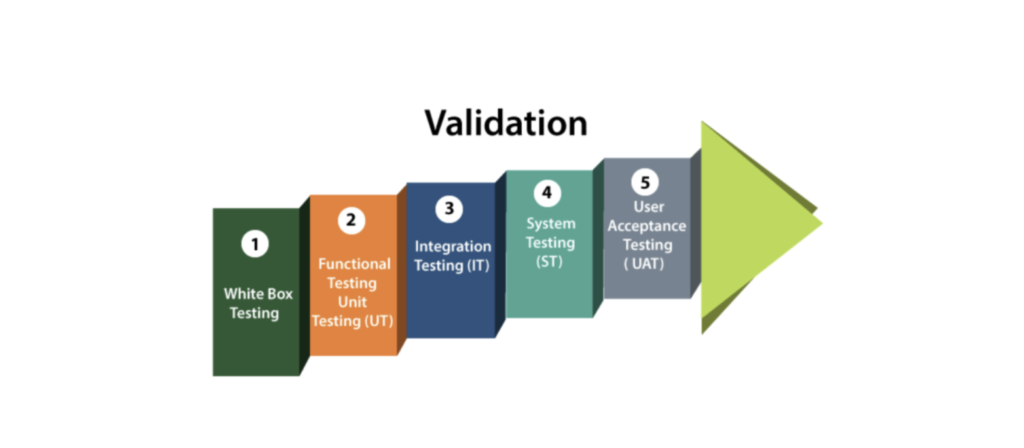
In the detailed world of software development, verification vs validation testing are key. They are central to quality assurance. Yet, they are different. Verification checks if a product meets specific design specs. Validation makes sure the final product does what it’s supposed to do1. Working together, these steps help create strong apps. They meet user needs and test requirements.
Key Takeaways
- Verification and validation are critical in a strong quality management system, like ISO 9000.
- Verification focuses on following rules, while validation aims to satisfy customers.
- The software development cycle greatly depends on both to make top-quality applications.
- These processes involve various checks to ensure machinery and software work well.
- Validation testing uses different methods to fit the specific needs of projects and industries.
- Examples of validation show its broad effect, from laws to renewing driver’s licenses.
Introduction to Software Testing and Quality Assurance
The software development lifecycle is always changing, with software testing and quality assurance at its heart. These areas make sure software works well, is secure, and performs smoothly. They define the user’s experience and protect a company’s image. Today, combining testing and quality assurance with development is essential.
Defining Software Testing
Software testing checks if a software application meets its requirements. It’s a key part of the software development lifecycle. The goal is to find bugs or defects early. There are many types of tests, like acceptance, integration, and unit tests. They all aim to make the product reliable and satisfying for the user. In 2016, software mistakes cost the US economy about $1.1 trillion.
Role of Quality Assurance in Software Development
Quality assurance makes sure software is of top quality and meets customer needs. It focuses on preventing errors through regression testing and enforcing standards. More and more, companies are testing continuously, from the start of a project to the end. This helps ensure the software is of high quality.
The Importance of Testing in Agile Methodology
The agile methodology depends on constant improvement and building things step by step. Testing is key in agile. It happens all the time, allowing for quick feedback and updates. Agile teams often automate testing to speed up delivery and fix issues fast. They use shift-left and shift-right testing to find defects early and test in real-world like conditions.
New tools make testing easier and more efficient. Automated testing tools help manage tests better. Other tools, like service virtualization, help test when parts of the system are still being built2. This leads to a stronger testing process. It also cuts down on time to market and costs. Good defect tracking is key for improving software and can save companies lots of money each year.
For more info on modern testing methods and their role in software, check out IBM’s insights on software testing. Here, new strategies meet market needs, encouraging innovation and keeping companies competitive.
Exploring Verification in Software Testing
Verification in software testing is key to creating high-quality systems. It uses reviews, walkthroughs, and inspections to catch errors early. It’s the foundation of strong quality assurance, making sure software meets both the maker’s and the user’s needs.
Verification checks if a system meets its requirements3. Test automation makes testing more effective, improving accuracy and efficiency. Each test case adds to the system’s reliability. Rigorous acceptance testing ensures products perform as intended in real-world conditions.
Verification is a team effort, needing ideas from developers and users alike. It shows that top-notch software comes from working together. Adapting verification methods based on project needs and risks is important.
Software is everywhere in our lives, making quality assurance vital. From space missions to our daily apps, verification is key to technology’s success.
Validation Testing: Ensuring Software Meets Customer Needs
In a world of complex software, validation testing ensures products meet users’ expectations. It dives into the practical use cases, beyond just theory. This makes sure the software experience is spot-on for end users.
Seen as a crucial step before launching software, validation testing comes in different types. Techniques like black box, white box, and non-functional testing are used. Each type aims to verify the software delivers on its promise. It’s this phase where the product must fulfill customer needs through careful validation.
Understanding the Concept of Validation
Validation involves detailed quality control steps to make sure software aligns with operational needs. It uses real-life scenarios to check if the software meets every user requirement. Done near the development end, it uses specific methods to prove the software’s worth.
Advantages of Validation in the Software Development Lifecycle
Validation stands out by catching defects that other tests might miss. It includes tests similar to race car durability challenges to examine software strength. This process ensures the software not only adheres to specs but also works well in its intended setting. Validation is crucial for meeting acceptance and making sure software meets exact user needs.
Comparing Verification vs Validation Testing: A Detailed Look
In software testing, it’s essential to know the differences between verification and validation. These processes are critical for software quality and user acceptance. They help meet safety and compliance while saving resources on testing Science-Based Stockpile Stewardship Program.
Key Differences in Objectives and Approaches
Verification focuses on making sure everything sticks to the plan. It finds and fixes problems before they become bigger issues. This method makes software more reliable. Groups like the American Society of Mechanical Engineers stress the importance of verification for safety and precision.
Impact on Software Quality and User Acceptance
Validation, however, checks if the software does what users need. It uses dynamic testing to ensure the product works well in real life. This helps in achieving high user acceptance.
For example, the U.S. Department of Defense uses these processes to ensure software reliability. This is crucial for systems like ballistic missile defense, where failure is not an option.
Regression testing makes sure new updates don’t mess up existing features. This balance is key in creating dependable software that meets customer needs.
In the end, V&V processes prove the software meets expectations through data. This establishes software quality and ensures users get what they need.
Verification Techniques: Boosting Software Reliability
Software reliability has grown thanks to verification techniques. Software failures can hit the economy hard. For example, in the United States, such issues cost about USD 1.1 trillion and impacted around 4.4 billion people in 2016. So, quality assurance is crucial. It protects the digital world that everyone depends on.
Using good testing strategies saves a lot of money. With verification techniques and test automation, companies can save millions each year. This isn’t just about money. It also helps protect a company’s reputation. When software comes out late or with bugs, it can make customers unhappy and they might leave. Verification in software testing uses methods like SpecChek™. This checks that every part of making the software matches the original plan.
Verification techniques are key in making software. They have been since after World War II. These methods have changed over time. Now they include test automation. This makes sure software works well in real life, not just in tests. This progress is a sign of how verification and making strong, lasting software go hand in hand.
FAQ
What is the fundamental difference between verification and validation testing in software development?
Verification checks if the software follows specific requirements through reviews and inspections. It does this without running the code. Validation, however, tests the software by running it. This makes sure it meets customer needs and works as expected.
How is software testing defined, and what role does it play in quality assurance?
Software testing evaluates if a system meets its requirements and functions right. It’s key for quality assurance. It finds bugs before users do, making sure the software is reliable and high-quality.
Why is testing particularly important in the Agile methodology?
In Agile, testing is part of the loop, offering quick feedback to developers. It allows for fast tweaks and better matches with what users need through development.
What does verification in software testing typically involve, and what are its goals?
Verification uses static analysis, like reviews and inspections, to check the coding against specs. Its goal is to catch and fix problems early, avoiding expensive mistakes later.
How does validation testing ensure that the software meets customer requirements?
Validation testing runs the software to see if it delivers what customers expect. It checks the software’s real-world use and if it meets the business needs.
Can you explain the key advantages of validation within the software development lifecycle?
Validation spots defects verification might miss and confirms specs were understood right. It’s key for making a product that meets user needs and market demands.
In what ways do verification and validation testing impact software quality and user acceptance?
Verification and validation together raise software quality by meeting specs and user hopes. This improves user acceptance as the final product works well and fits user needs.
What are some common verification techniques used to improve software reliability?
Key verification methods include thorough document reviews, teamwork-focused walkthroughs, and self-review by developers. These catch early defects, ensuring the software meets quality standards.
Future App Studios is an award-winning software development & outsourcing company. Our team of experts is ready to craft the solution your company needs.










